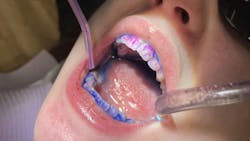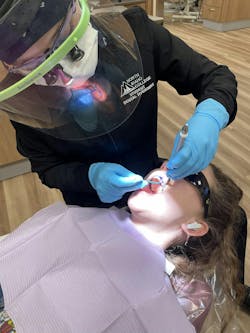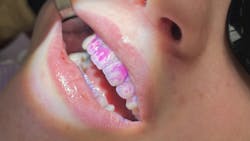Disclosing solution agents: Helping educate patients about the presence of dental biofilm
Oral hygiene instruction is crucial during dental checkups. As dental professionals, we often spend considerable time explaining the importance of a thorough oral care routine to our patients. The goal is to motivate patients to understand their current oral health status and to prevent future issues. However, despite reviewing and suggesting improvements to patients’s home-care regimens, we may feel our recommendations are ignored.
Educating patients can be challenging, as different individuals have varying learning styles. Visual aids can be an effective tool for patient instruction. If you believe your patients would better understand oral biofilm through visualization, consider using disclosing solutions to help illustrate the presence of dental biofilm.
A closer look at disclosing agents
Disclosing agents were developed years ago to help oral hygiene patients become better at recognizing what biofilm is and where it is being left behind in the oral cavity, despite the patient believing they had done a thorough job at removing it. Disclosing agents come in several different forms—liquids, gels, or tablets—and are manufactured by various companies. Oral professionals may feel differently about which form is the easiest to use in the dental operatory.
It’s important to recognize that there are different types of disclosing agents, and certain ones may be more beneficial for patient education than others. The first disclosing agent marketed only contained erythrosine dye to highlight biofilm accumulation on oral surfaces in red.
Shortly thereafter, two- and three-tone disclosing solution agents became available. Two-tone disclosing agents stain in two colors, blue and red, with the biofilm that has been sitting on the patient’s teeth for quite some time turning blue and newer biofilm turning red. Three-tone disclosing agents stain old and new biofilm similar to two-tone disclosing agents, but they also highlight the cavity-producing bacteria a purple color. No matter which disclosing solution you choose to apply, the end goal is the same: highlight the plaque while motivating and encouraging the patient to improve their oral hygiene regimen.1-7
Techniques for using disclosing solutions
Introducing a disclosing agent to highlight a patient’s biofilm accumulation can be done very efficiently. First, inquire if the patient has recently brushed after eating and drinking. This is important so that deposits of biofilm accumulation can be more easily recognized. Next, apply the disclosing agent. If it is a liquid, instruct the patient to swish the agent around in their mouth and then expectorate after rinsing. You may need to suction any remaining disclosing liquid from the patient’s oral cavity.
When using a gel disclosing agent, rub the gel onto the patient’s teeth with a cotton-tip applicator and then rinse it away. Tablet-formed disclosing agents are chewed until they become liquid. The patient can swish the agent around in their mouth and then expectorate after rinsing. Again, any remaining solution may need to be suctioned from the mouth.
After all disclosing agents have been applied, we can codiscover with the patient to see the biofilm remaining and note where it is located. Ask open-ended questions to help the patient recognize how the biofilm accumulation might still be present, even though the patient may have believed they removed it all during their oral hygiene regimen. Assure patients that the highlighting benefits of disclosing agents are only temporary; the patient can remove it by brushing it away.1
Options for disclosing agents
Disclosing agents have changed with time to accommodate patients’s needs. Some companies manufacture erythrosine and gluten-free disclosing solutions.5 Patients who are quick to recognize the ease and benefits of disclosing agents may be pleased to know that they can be purchased over-the-counter. Disclosing agents do not have a long shelf life, so users should check their expiration date to make sure they will work properly.3 Dental professionals can request free samples on manufacturers's websites.5-7
Research about disclosing agents
It might be time to enhance your oral hygiene appointments. Disclosing agents, regardless of type, are excellent tools for educating patients about biofilm—what it is, why it needs to be removed, and where it commonly lingers. These disclosing agents can significantly help patients understand how to improve their dental checkups.
Editor’s note: This article first appeared in Clinical Insights newsletter, a publication of the Endeavor Business Media Dental Group. Read more articles and subscribe.
References
- Pieren JA, Gadbury-Amyot CG. Darby and Walsh Dental Hygiene Theory and Practice. 6th Elsevier; 2025:268.
- What disclosing tablets can tell you about plaque. Colgate-Palmolive Company. August 30, 2024. https://www.colgate.com/en-us/oral-health/plaque-and-tartar/disclosing-tablets-plaque#
- Davis K. To disclose or not to disclose? Routine use of disclosing agents helps the dental clinician out too. RDH December 13, 2016. https://www.rdhmag.com/patient-care/article/16409247/to-disclose-or-not-to-disclose-routine-use-of-disclosing-agents-helps-the-dental-clinician-out-too
- Auger A. Plaque HD: Highlighting plaque for effective home care. June 6, 2016. https://www.dentistryiq.com/dental-hygiene/clinical-hygiene/article/16352551/plaque-hd-highlighting-plaque-for-effective-home-care
- Disclosing agents and disclosing solutions: tracking down plaque. Young Innovations. 2024. https://www.youngdental.eu/en/disclosing-agents-and-disclosing-solutions/
- TePe PlaqSearch — efficient plaque control. TePe Oral Health Care. 2024. https://www.tepeusa.com/pages/tepe-plaqsearch
- GC Tri Plaque ID gel dental plaque disclosing gel. GC America Inc. 2024. https://www.gc.dental/america/products/operatory/preventive/gc-tri-plaque-id-gel
- Yavan MA, Kocahan S, Özdemir S, Sökücü O. The effects of using plaque-disclosing tablets on the removal of plaque and gingival status of orthodontic patients. Turk J Orthod. 2019;32(4):207–214. doi:10.5152/TurkJOrthod.2019.18084
- Fasoulas A, Pavlidou E, Petridis D, Mantzorou M, Seroglou K, Giaginis C. Detection of dental plaque with disclosing agents in the context of preventive oral hygiene training programs. Heliyon. 2019;5(7):e02064. doi:10.1016/j.heliyon.2019.e02064
- de Alencar CR, de Oliveira GC, Tripodi Jr CDV, et al. Dental plaque disclosing as an auxiliary method for professional dental prophylaxis in early childhood. Int J Clin Pediatr Dent. 2019;12(3):189-193. doi:10.5005/jp-journals-10005-1617
About the Author
Tracee S. Dahm, MS, BSDH, RDH
Tracee S. Dahm, MS, BSDH, RDH, is an adjunct clinical instructor for the North Idaho College School of Dental Hygiene in Coeur d’Alene, Idaho, and she also works in private practice. She has been published in several dental journals, magazines, webinars, and textbooks. Tracee is a key opinion leader on cutting-edge innovations in the hygiene field. Her research interests include trends in dental hygiene, improving access to dental care for the underserved, and mental health. Contact her at [email protected].





